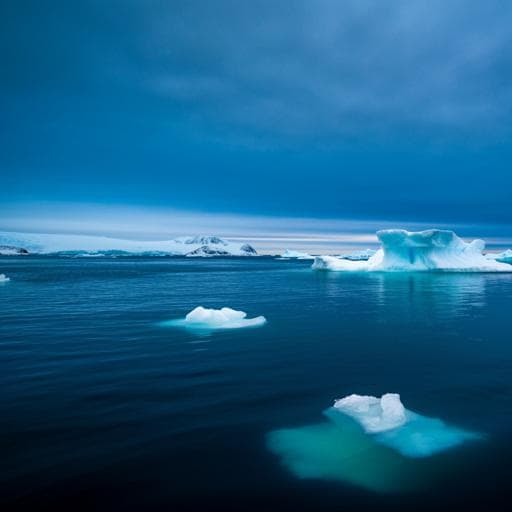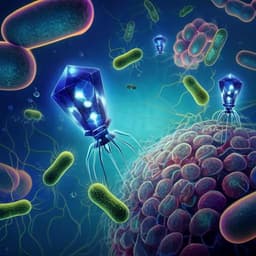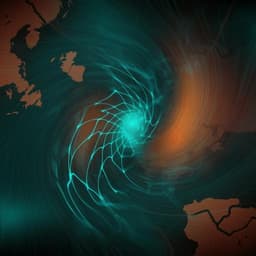
Earth Sciences
Vulnerability of the North Water ecosystem to climate change
S. Ribeiro, A. Limoges, et al.
Explore the delicate balance between high Arctic ecosystems and Indigenous livelihoods as researchers, including Sofia Ribeiro and colleagues, unravel the historical sensitivities of the North Water polynya. Discover how climate changes over millennia have influenced this vital marine habitat and the future risks posed by warming temperatures.
~3 min • Beginner • English
Introduction
The study investigates the vulnerability of the North Water (NOW) polynya ecosystem to climate change, framed by the IPCC risk concept linking exposure, hazard, and vulnerability. The NOW, the largest and most productive polynya in the Northern Hemisphere, sustains keystone Arctic species and underpins Indigenous Inuit livelihoods. Its seasonal ice-free conditions depend on the winter formation of a stable ice arch in Nares Strait that blocks export of multiyear sea ice and promotes conditions for early, intense phytoplankton blooms. Recent tendencies toward earlier ice arch collapse and instability raise concerns about the persistence of the NOW under warming. To inform risk evaluation and adaptation planning, the study aims to provide a long-term perspective on sea ice, marine productivity, and seabird (little auk) colony dynamics and their links to human presence in Greenland.
Literature Review
Background work documents the ecological and cultural importance of the NOW polynya, its upwelling-driven productivity, and its role in sustaining Arctic cod, seabirds, and marine mammals. Prior studies identify diatoms as key primary producers, with Chaetoceros producing preservable resting spores reflecting productivity. The NOW hosts >80% of the global little auk breeding population, and seabirds transfer marine-derived nutrients to land, reshaping coastal ecosystems; sedimentary indicators track colony dynamics. The formation of the Nares Strait ice arch is sensitive to sea ice thickness, wind forcing, and ocean heat, with satellite-era observations showing increased instability and earlier break-ups. Climate modes such as the Arctic and North Atlantic Oscillations (AO/NAO), Atlantic Multidecadal Variability (AMV), and the Dipole Anomaly (DA) modulate sea ice and ocean-atmosphere conditions relevant to polynya dynamics. Archaeological and genetic research outlines prehistoric migrations into Greenland and periods of human presence/absence that may relate to environmental conditions.
Methodology
The authors use a retrospective, multi-proxy approach integrating marine and lake sediment cores to reconstruct mid-to-late Holocene sea ice conditions, marine primary production, and little auk colony dynamics.
- Study sites and cores: A marine gravity core (AMD15-CASQ1; 543 cm) and companion box core (40 cm) were collected from central Smith Sound (77°15.035′ N, 74°25.500′ W; 692 m water depth), south of the southernmost ice arch location. A lacustrine piston core (NOW25c; 177 cm) was taken from a lake at Annikitsoq, Cape York Peninsula (76°2.100′ N, 67°36.540′ W; 8.1 m a.s.l.; lake depth 34 m). The lake lies ~1 km from the Greenland Ice Sheet edge and directly below a large little auk colony.
- Chronology: Marine core age control used 11 AMS 14C dates on mollusc shells (calibrated with Marine13/IntCal13; regional reservoir offset AR = 140 ± 60 years) and 210Pb/137Cs profiles for the box core; a mixed Bayesian age-depth model (BACON) combined both. Lacustrine core age control used 10 AMS 14C dates (mostly terrestrial moss), calibrated with IntCal13; a BACON age-depth model provided ages in cal yrs b2k. Sedimentation rates were estimated; marine rates ranged ~0.09–0.27 cm yr−1 (gravity) and 0.4–0.67 cm yr−1 (box), TOC ~1.5–2%; the lake exhibits a sharp transition at 150 cm dating to 4400–4200 cal yrs b2k with a 4-fold increase in sedimentation and LOI up to 80% thereafter.
- Marine primary production proxies: Diatom fluxes were quantified (valves cm−3 yr−1) including total diatoms and Chaetoceros resting spores as productivity indicators. Samples were treated (H2O2, HCl), mounted in Naphrax, and counted microscopically at 1000x; fluxes combined concentrations with mass accumulation rates.
- Sea ice biomarkers: IP25 (sympagic diatom HBI) and HBI III (pelagic diatoms in marginal ice zone) were extracted from hydrocarbon fractions via GC-MS; abundances expressed as fluxes to account for changing sedimentation rates. Analytical protocols included internal standards, extraction (DCM:MeOH), silica cleanup, GC-MS identification and quantification.
- Lake proxies for little auk presence/abundance: Multiple indicators were used: δ15N (marine-derived nutrients), Cd:Ti ratios (Cd enrichment from guano relative to catchment-derived Ti), sterol concentrations and fluxes (cholesterol high in marine zooplankton vs β-sitosterol high in terrestrial/freshwater producers), and diatom assemblage changes (acidophilous taxa dominance with peatland development and lake acidification). Sterols were extracted, fractionated, derivatized, and quantified by GC-FID/GC-MS with standards; modern excrement comparisons confirmed high cholesterol and low β-sitosterol in little auk guano. Lake diatoms were analyzed at 1–3 cm resolution with ≥400 valves counted per sample.
- Supporting measurements: Lake sediment LOI at 1 cm resolution; XRF core scanning (ITRAX) for elemental counts (e.g., Ti, Cl) at 0.1 mm step, aggregated to ≥1 mm for low-count elements.
- Modern context: Satellite passive microwave sea ice concentration (NOAA/NSIDC CDR) for MJJAS (1979–2015) assessed in two regions (NOW and Ice Arch), alongside Pituffik (Thule) air temperature anomalies and AO index.
- Numerical analyses: Monte Carlo simulations (n=10,000) incorporated measurement and age uncertainties for constituent time series. Principal Component Analysis (PCA) derived PC1 for marine (diatoms, Chaetoceros spores, HBI III) and lake (Cd:Ti, δ15N, fractional sterol, lake diatom index) records, interpreted as primary production (marine) and little auk abundance (lake). Generalized Additive Models (GAMs) with REML + CAR(1) or GCV identified significant change points via first derivatives with 95% CIs.
Key Findings
- The NOW polynya was a stable, highly productive ecosystem by 4400–4200 cal yrs b2k, coincident with the first human arrivals in Greenland and the establishment of little auk colonies. Lake core shows a sharp transition at 150 cm (4400–4200 cal yrs b2k) with a 4-fold increase in sediment accumulation and LOI up to 80%, reflecting strong seabird influence and catchment productivity.
- Marine proxies indicate high diatom fluxes and high IP25 with minimal HBI III during 4400–2700 cal yrs b2k, consistent with stable, recurrent seasonal sea ice and prolonged open-water conditions conducive to high productivity.
- From ~2700–2200 cal yrs b2k, lake indicators (δ15N, cholesterol, acidophilous diatoms) decline earlier than marine proxies, culminating in a short-lived colony abandonment around ~2300 cal yrs b2k at the lake site; marine primary production drops significantly after ~2200 cal yrs b2k.
- A sustained period of polynya contraction and instability spans ~2700/2200–800 cal yrs b2k, encompassing the Roman Warm Period and Dark Ages Cold Period, and aligns with a millennium-scale human abandonment of Greenland (~2200–1200 cal yrs b2k).
- After ~800 cal yrs b2k through the Little Ice Age, conditions stabilize but with relatively lower marine diatom fluxes; little auk colonies recover (rising δ15N, cholesterol ratio), and acidophilous lake diatoms re-dominate. Air temperatures were up to ~3 °C cooler than at 4400–4200 cal yrs b2k.
- Climate forcing links: Predominantly weakly positive NAO and low AO variability align with early stability (4400–2700 cal yrs b2k); the instability period (~2700/2200–800 cal yrs b2k) coincides with abrupt climate anomalies, strengthened latitudinal gradients, southward Polar Front migration, cooler/fresher West Greenland waters (2600–1900 cal yrs b2k), ocean warming episodes (especially RWP) via increased Atlantic water in the West Greenland Current, and episodes of strongly positive AO.
- Recent decades show increasing polynya instability: earlier Nares Strait ice arch break-up, enhanced export of Arctic sea ice into Baffin Bay, increased late spring/summer drift ice and melt in the NOW region, reflected by increased sedimentary sea ice biomarker fluxes. Present-day High Arctic air temperatures are unprecedented in the history of the NOW.
- On current warming trajectories, the NOW is likely to cease functioning as a unique ice-bounded open-water ecosystem and winter refuge for keystone species, posing significant risks to Indigenous livelihoods dependent on NOW resources.
Discussion
The multi-millennial reconstructions demonstrate that the NOW ecosystem’s productivity and stability are tightly coupled to sea ice dynamics controlled by atmospheric and oceanic variability. Stable, productive conditions facilitated both little auk colony establishment and human migrations into Greenland around 4400–4200 cal yrs b2k. Conversely, the interval of polynya instability and reduced productivity (~2700/2200–800 cal yrs b2k) corresponds with significant cultural hiatuses, including the millennium-scale human abandonment of Greenland, underscoring the socio-ecological sensitivity to marine resource variability. The analyses link these ecosystem shifts to climate modes (AO/NAO, AMV) and oceanographic changes (e.g., West Greenland Current influence), where positive AO phases and altered sea ice motion/export degraded ice arch stability and polynya function. During the Little Ice Age, a return to more stable sea ice conditions allowed partial ecological recovery albeit at lower productivity. Contemporary observations reveal accelerating instability driven by anthropogenic warming and sea ice thinning, indicating that future conditions may exceed the range of Holocene variability and threaten the persistence of the NOW and associated Indigenous resource systems. The findings thus directly address the research question by quantifying the vulnerability of the NOW through past analogues and connecting these to mechanisms and present trends.
Conclusion
This study provides a long-term, multi-proxy reconstruction of the North Water polynya demonstrating: (1) a stable, highly productive ecosystem established by 4400–4200 cal yrs b2k that supported little auk colonies and early human presence; (2) a prolonged period of instability and reduced productivity from ~2700/2200 to 800 cal yrs b2k associated with human abandonment; (3) a later return to more stable but less productive conditions with little auk recovery during the past millennium; and (4) increasing modern instability under rapid warming. The concordance between ecosystem decline and cultural hiatuses highlights the vulnerability of Indigenous livelihoods to sea ice-driven changes in marine productivity. Given ongoing warming and sea ice loss, the NOW is at risk of collapse as a unique ecosystem. The authors emphasize the need for enhanced ecosystem monitoring, conservation of living resources, and co-developed management with Indigenous communities, including consideration of an Indigenous Protected Area for the NOW. Future research should refine mechanistic links among climate modes, ocean heat transport, and ice arch dynamics; improve spatially resolved proxy records; and integrate socio-ecological modeling to inform adaptation strategies.
Limitations
The authors note several constraints: (1) Dating uncertainties in both marine and lake records, including reservoir age corrections for marine 14C, may affect precise phasing of events; (2) Spatial representativeness differs between sites—the marine core is central to the polynya, whereas the lake site lies near the southern edge, likely recording contractions earlier; (3) Proxy-specific caveats exist, such as sterol ratio interpretations in highly eutrophic systems and potential catchment storage/release effects on δ15N and Cd; (4) PCA interpretations focus on the first principal component, potentially omitting secondary signals; (5) Temporal resolution limits and preservation biases may influence proxy sensitivity. These factors could affect the timing and magnitude of inferred changes and their generalizability.
Related Publications
Explore these studies to deepen your understanding of the subject.







